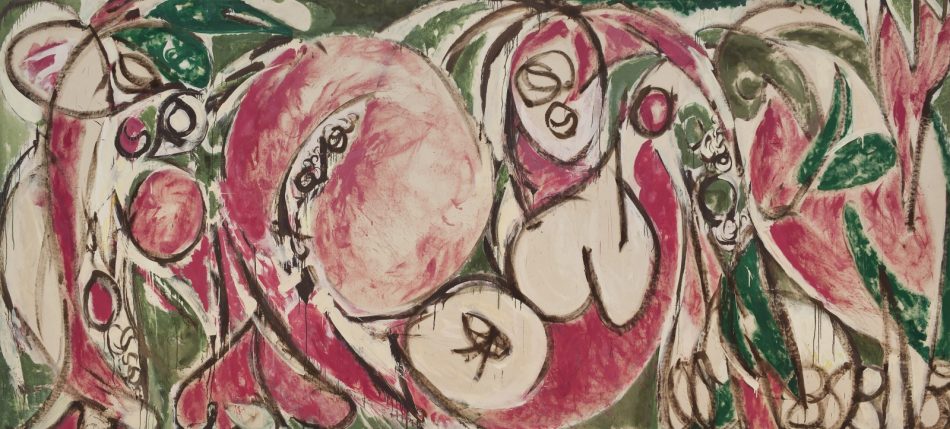
Lee Krasner, The Seasons, 1957. Oil and house paint on canvas.
Abstract Expressionist Women at DAM in Review
The 2001 edition of The 20th-Century Art Book defines Abstract Expressionism as a post-World War II art movement in American painting, developed in New York in the 1940s. Ab Ex came to describe a specific group of primarily male artists committed to an expressive and profoundly emotional art that arched to individual ideals of universalism. So where have the Abstract Expressionist women been?
Jackson Pollock is usually credited with revolutionizing art because of his process. He put raw, unstretched canvas on the floor and dripped, threw, stained and brushed paint onto and beyond the edge of the canvas. He may have adopted the technique from Ukrainian-American artist Janet Sobel, who made her first drip painting in 1944. Pollock saw her work with critic Clement Greenberg in 1946 at Peggy Guggenheim’s The Art of This Century Gallery and the next year Pollock began flinging and pouring paint. The style caused him to become the face of American painting when in 1949, Life magazine posed the question: “Jackson Pollock: Is he the greatest living painter in the United States?”
Pollock met his wife, the artist Lee Krasner, in 1942 after they both exhibited at the McMillen Gallery in New York. Krasner famously said: “When I first saw his paintings, I nearly died.” The Abstract Expressionist woman artist went on to champion his genius, some say to the detriment of her own career.
“I’m always going to be Mrs. Jackson Pollock—that’s a matter of fact—[but] I painted before Pollock, during Pollock, after Pollock,” Krasner said.
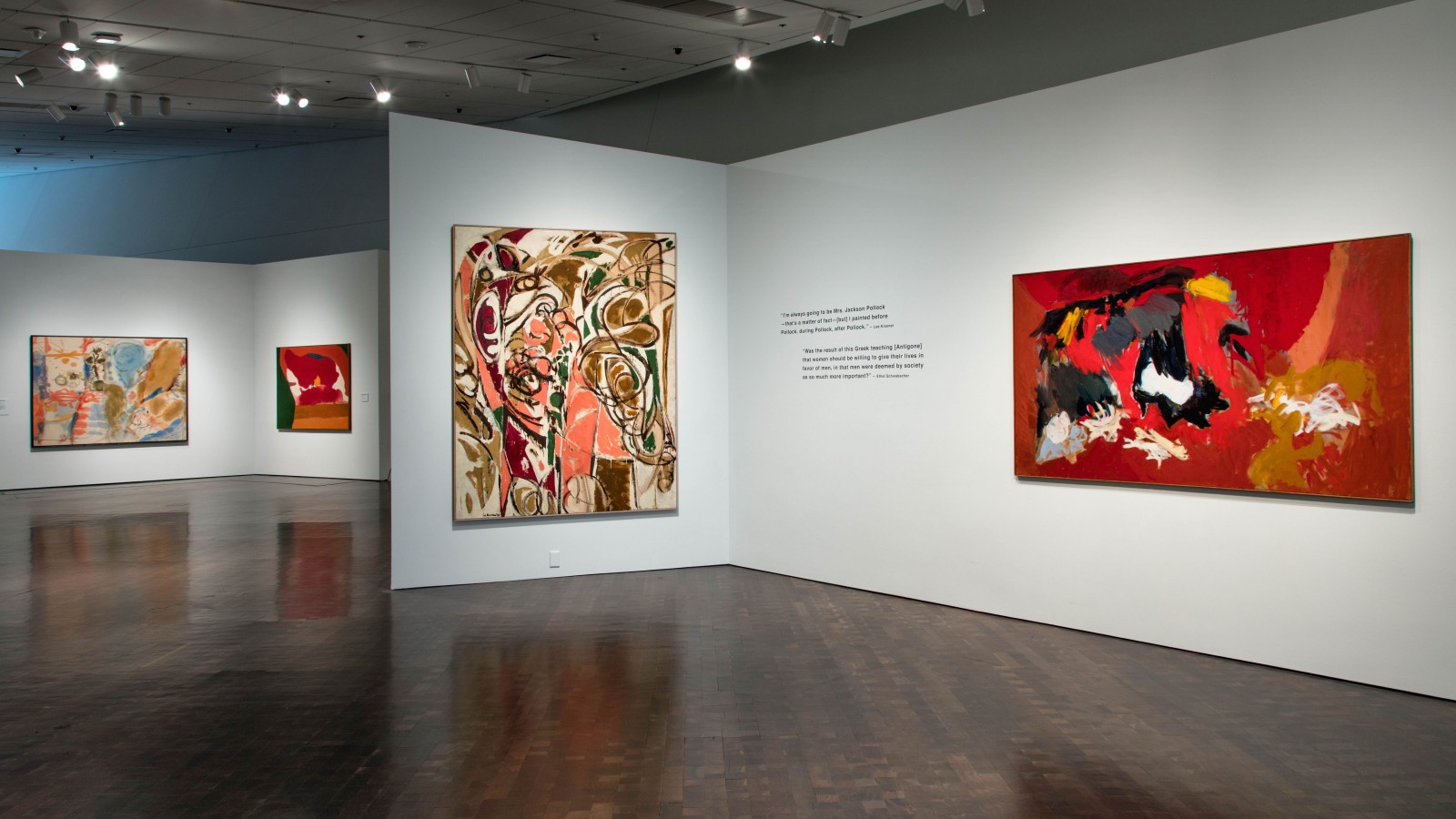
This quote greets visitors to Denver Art Museum’s exhibition Women of Abstract Expressionism, along with another by artist Ethel Schwabacher: “Was the result of this Greek teaching [the classic play of Sophocles, Antigone] that women should be willing to give their lives in favor of men, in that men were deemed by society as so much more important?”
The answer for decades has been yes, men are more important.
This new exhibition features 51 paintings, created in the 1940s and 1950s, by 12 women artists: Mary Abbott, Jay DeFeo, Elaine de Kooning, Pearle Fine, Helen Frankenthaler, Sonia Gechtoff, Judith Godwin, Grace Hartigan, Lee Krasner, Joan Mitchell, Deborah Remington, and Ethel Schwabacher. The exhibit takes over the entire fourth floor of the Hamilton Building.
The paintings include large, textured, stained, all-over canvas creations like Schwabacher’s Antigone I, from 1958, a 51 x 82 ¼ inch canvas of blood red, ochre, black, blue, gray and white markings that is a figurative abstraction of the Greek myth. And Krasner’s The Seasons from 1957, a 92 ¾ x 203 7/8 inch work on loan from the Whitney Museum of American Art created after Pollock’s death. Krasner said she painted it with tears streaming down her face. The painting is Matisse-esque with dark marks and lines, highlighted by red, pink and green stained-and-painted sections suggesting seedpods and ripe fruit.
Denver Art Museum purchased Elaine de Kooning’s Bullfight from 1959, a 77 5/8 x 131 ¼ inch canvas, in 2012. Its vivid yellows, reds and greens are jagged and alive, only its title hinting at the event of the bullfight.
Women artists have been historically dismissed as not creating work of the same caliber as the men who were their husbands or teachers. There is Krasner and Elaine de Kooning, wife of Willem de Kooning. Grace Hartigan, close friend of Willem de Kooning, who in the ’50s changed her name to George in the spirit of George Eliot or George Sand.
When asked if a male artist ever told her she painted like a man, Grace Hartigan replied, “Not twice.”
There are also these women: Ethel Schwabacher, student and close friend of Arshile Gorky. Sonia Gechtoff, wife of painter James Kelly. Deborah Remington who studied with Clyfford Still. And Zoe Longfield, one of the few Ab Ex women Still admitted into his inner circle.
Helen Frankenthaler, who studied with Hans Hoffman, might be the exception to the overlooked Women of Abstract Expressionism rule as her paintings have often been included in scholarship and exhibitions.
Krasner, who studied cubism at Cooper Union and then painted murals for the WPA, also studied with Hans Hoffman. She engaged in the intellectual debates about painting with Pollock and Willem de Kooning. But in spite of her arguing that painting should be large and should expand beyond the boundaries of the frame, she is considered a lesser painter of the 1940s when she produced her Little Image series—small, exquisite works.
Katy Siegel, in a talk at the Whitney Museum on September 4, 2015, said that when one visits the Pollock/Krasner house in Springs, New York and sees where Krasner worked at a small table in a bedroom, one understands that a lack of space prescribed her working in small size while Pollock was living. It wasn’t until after Pollock died (1956) that Krasner took over his larger studio in the barn and created enormous works like The Seasons. When the new Whitney opened last year, Siegal called The Seasons the strongest painting in the seventh-floor gallery.

Lee Krasner, The Seasons, 1957. Oil and house paint on canvas; 92 3/4 x 203 7/8 in. Whitney Museum of American Art, New York; purchase, with funds from Frances and Sydney Lewis by exchange, the Mrs. PErcy Uris Pruchase Fund and the Painting and Sculpture Committee 87.7 Photograph by Sheldan C. Collins. (c)2015 Pollock-Krasner Foundation/Artists Rights Society (ARS), New York.
The art critic Irving Sandler, in a 2013 interview with art critic Joan Marter, said: “I really hate to say this, but there didn’t seem to be women of the stature of, say, Mark Rothko, Bill de Kooning, Jackson Pollock. They just weren’t there.”
When Marter pushed back with the names of women painters, Sandler reiterated that he didn’t think they were of the same stature as the men of the first generation of Abstract Expressionists working before 1950. Of the second generation, Sandler allowed: “The important thing to remember is that Helen Frankenthaler, Grace Hartigan, and Joan Mitchell were the really strong painters. They were the strongest painters at the time.”
(The issue of second-generation Ab Ex women, whose best work is critically considered to have occurred after 1950, is one that many women artists felt was dismissive of the actual timing of their development and work.)
The Women of Abstract Expressionism exhibition features Frankenthaler’s breakthrough stain painting Mountain Storm, Jacob’s Ladder on loan from The Museum of Modern Art and Western Dream, one of my favorites. Hartigan’s large, colorful painting from 1950, The King is Dead, about Picasso, hangs with other of her lush works. Nearby are six of Mitchell’s frenetic works created between 1952-1956.
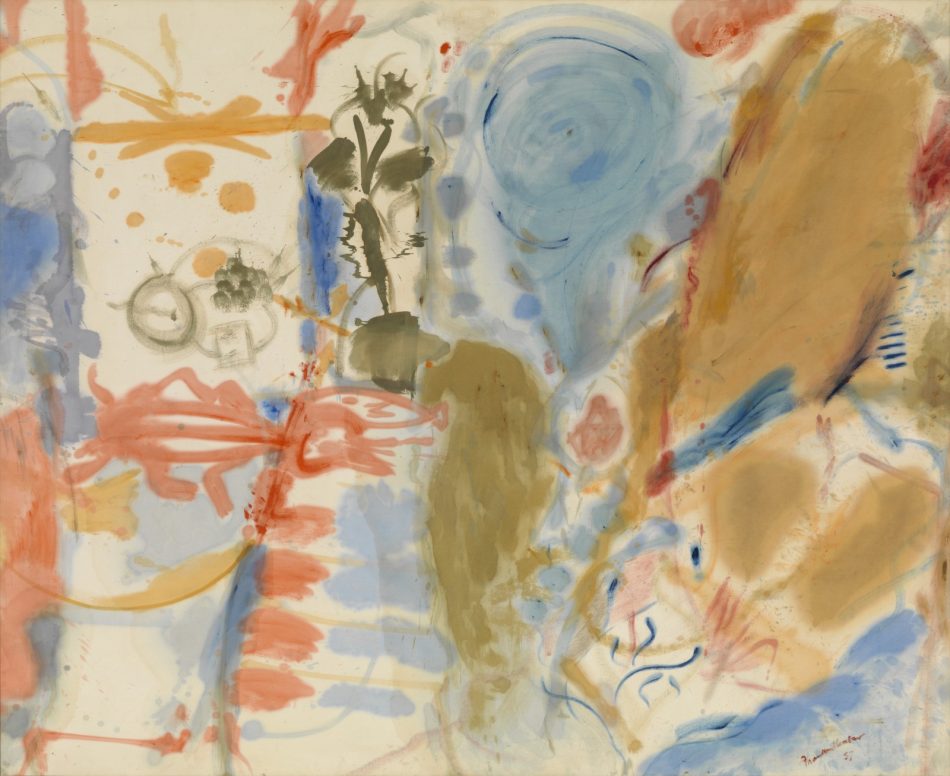
Helen Frankenthaler, Western Dream, 1957. Oil paint on unsized, unprimed canvas; 70 x 86 in. Helen Frankenthaler Foundation, New York. (c)2016 Helen Frankenthaler Foundation/Artists Rights Society (ARS), New York. Photography by Rob McKeever, courtesy Gagosian Gallery.
I interviewed Curator Gwen Chanzit on June 21, 2016, at the Denver Art Museum where she said: “The most surprising thing to me was that nobody had done this show before.”
Chanzit said she did not set out to do a woman’s show, but that she kept thinking of the possibilities of exhibiting the Women of Abstract Expressionism after viewing Action/Abstraction: Pollock, de Kooning and American Art, 1940-1976 at the Jewish Museum in 2008.
“On the plane ride home I kept wracking my brain. It was amazing to me that an exhibition on the topic hadn’t been organized. And it is surprising that more of these women painters still are not known.”
She began working in earnest five years ago.
The result is an exhibition divided into twelve individual spaces for each of the 12 women with a biographical wall text featuring a quote, a brief bio and images of the artists from the period. A kitschy educational lounge is decked out in 1950s-style furniture with more photos of the artists and their male counterparts at exhibits and gatherings, and a playlist of music (mostly jazz) from the time period (available on Spotify).
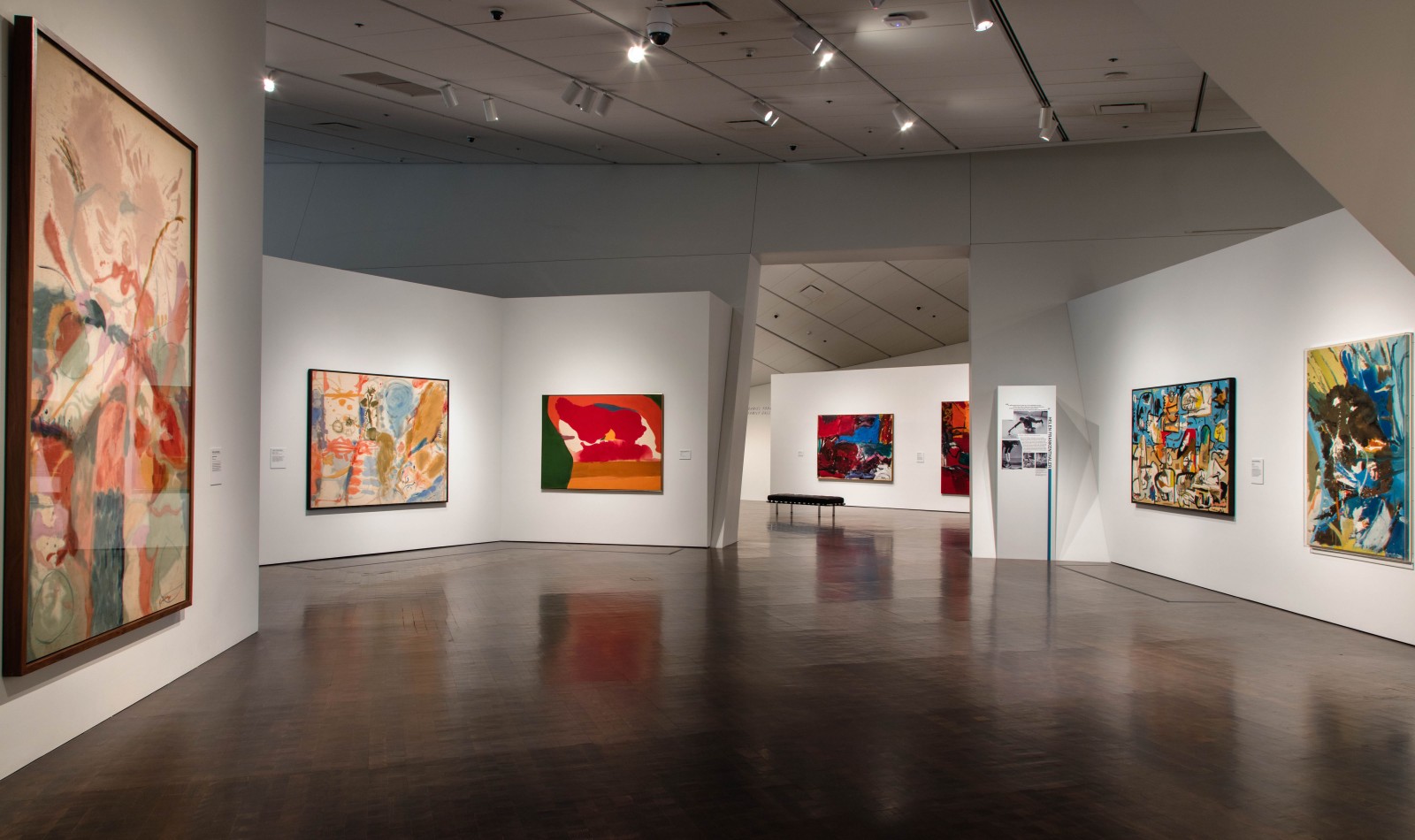
Accompanying the exhibit is a 251-page catalog, edited by Joan Marter, featuring an interview with Irving Sandler and essays by Chanzit, Marter, and scholars Ellen G. Landau, Susan Landauer, and Robert Hobbs along with plates of the exhibition art and biographies on 40 female artists. This includes the twelve in the exhibition and 28 additional: Ruth Abrams, Ruth Armer, Janice Biala, Bernice Bing, Joan Brown, Madeline Dimond, Amaranth Ehrenhalt, Claire Falkenstien, Lilly Fenichel, Shirley Goldfarb, Gertrude Greene, Buffie Johnson, Ida Kohlmeyer, Zoe Longfield, Mercedes Carles Matter, Emiko Nakano, Charlotte Park, Betty Parsons, Pat Passlof, Vita Petersen, Lil Picard, Anne Ryan, Sonja Sekula, Janel Sobel, Vivian Springford, Hedda Sterne, Alma Thomas, Yvonne Thomas, Michael West, and Jane Wilson. Chanzit said they looked at more than 100 artists while developing this exhibition.
Not only gender inequity, but also geographical myopia identified this period, according to Chanzit’s exhibition. Abstract expressionism was centered in New York City, but one could say the West deeply influenced the group.
At the height of his career, Pollock painted in a barn in Springs, New York, but he was born in Cody, Wyoming in 1912 and grew up in Arizona and Chico, California, experiencing Native American cultural symbols, which may have influenced his work as glyphs and motifs, what Jung called archetypes, emerged during his Jungian analysis. Clyfford Still was born in North Dakota and spent his childhood in Spokane, Washington and Alberta, Canada. Mark Rothko, whose family emigrated from Dvisnk, Russia, grew up in Portland, Oregon and his first one-person museum exhibition was at the Museum of Art in Portland. Adolph Gottlieb and his wife Esther Dick moved to Arizona in 1937 where they lived for a year.
Chanzit makes it a point to let us know that the women artists from San Francisco were not subjected to the same gender discrimination their female peers in New York received.
“I never felt any kind of resentment toward me because I was a woman…I had none of the hang-ups to deal with that the women in New York had to deal with,” artist Sonia Gechtoff said. Gechtoff, who worked in San Francisco, was included in the 1954 exhibit at the Solomon R. Guggenheim Museum in New York, Younger American Painters as well as the in the United States Pavilion at the Brussels World’s Fair in 1958, the same year she moved to New York where she described the atmosphere as discouraging, unsupportive and misogynistic.
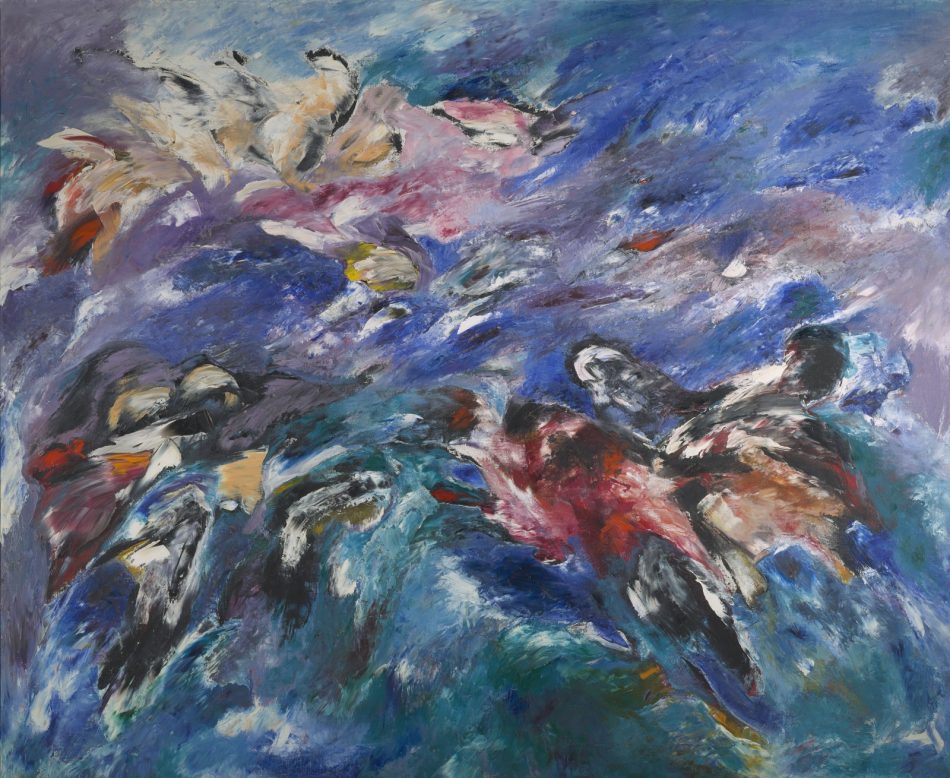
Sonia Gechtoff, The Beggining, 1960. Oil paint on canvas; 69 x 83 in. Denver Art Museum: Vance H. Kirkland Acquisition Fund, 2015.62. (c)Sonia Gechtoff.
“When my mother was painting abstract expressionist works, it was particularly difficult for the women because they were not recognized by the men as being proper vehicles or embodiment of the movement because they thought that they [the men] were the embodiments of that movement and that the women were collateral,” Christopher Schwabach said, in a short film that accompanies the exhibition.
The women as “collateral” produced works often more experimental than the mens’, tied into figuration inspired by dance, as well as ideas and themes from philosophy and poetry. The women were often free to explore and try new things. They didn’t have to adhere to being in New York as the new seat of power in art.
However, the divide between the collaborative and relatively more open atmosphere of the West Coast artists and the New York School is clearly on display in this exhibition and its related materials. In her catalog essay titled The Advantages of Obscurity Women Abstract Expressionists in San Francisco, Susan Landauer points out that after 1950, when Clyfford Still left San Francisco for New York, “[The California School of Fine Arts] entered an era of unparalleled opportunity, in which women were not just participants, but became leaders of artistic activity.” Landauer suggests that remaining in San Francisco and working in obscurity was a benefit to these artists who developed their own, often whimsical approach to abstraction.
Yet, Irving Sandler also dismisses West Coast artists in his interview with Joan Marter.
“Remington and Gechtoff are very interesting artists. But they had their own group,” Sandler said.
“Isn’t it fair to say that after Still leaves the area, that these artists on the West Coast are part of a broader view of Abstract Expressionism?” Marter asks.
“Absolutely. But they are sort of separate from us in New York.”
It remains a twisted fact of art history that Sandler dismissed the women painters for not being in New York and not working big enough, though they worked large often earlier than the men. And for not being inventive enough, though Janet Sobel was arguably the first to drip paint.
The 12 women, selected by Chanzit, stand in at the very least for the other 28 included in the catalog, and the 100 the curator considered. Yet this exhibit seems more like a rhetorical gesture than a distinct step toward reframing art history.
Chanzit said. “The women didn’t come late, as some would say. And the women didn’t only paint small. I think it’s just time to do a reassessment of their role. Of course there are others who haven’t been recognized. I hope this is an exhibition that will spur more exhibitions and more attention to who may have been left out of mainstream histories of abstract expressionism.”
The real beneficiary of Chanzit’s exhibition is the Denver Art Museum. Because of the exhibition, the museum has eight new acquisitions and three promised gifts. On the second floor is a smaller display of Abstract Expressionism from the Denver Art Museum featuring works by Betty Parson, Janice Biala, Robert Motherwell, Theodore Stamos, Lee Krasner, Deborah Remington, Norman Bluhm, Grace Hartigan, Philip Guston, and Dune, the museum’s 1970 Joan Mitchell along with a smaller one of Mitchell’s works on paper.
Brenda Webster, Ethel Schwabacher’s daughter, herself a critic and author, makes a poignant statement that so many women can understand: “My mother, though she was struggling for recognition did not want to be recognized as a woman. She hated it when people referred to her as a woman painter. She wanted to be a painter. Period.”
For this very reason, Lee Krasner chose not to sign her paintings or to use only her initials or hide the signature, to not be singled out as female. Other artist changed their names: Grace Hartigan became George Hartigan and Gertrude Green went by Peter, Jay De Feo thought her name was helpful in winning the opportunity to go abroad early in her career. Lena Krassner changed her name to the gender neutral Lee Krasner.
Hans Hoffman famously said to Lee Krasner of her painting: “This is so good you would not know it was painted by a woman.”
If only exhibitions did not have to use gender nomenclature and full equity had been achieved in art.

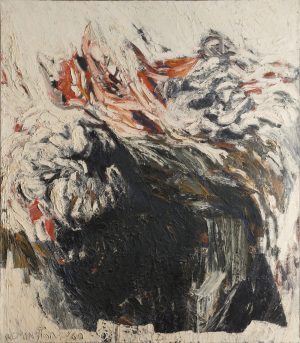
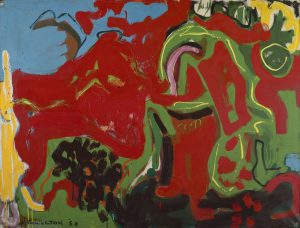
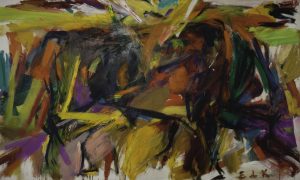
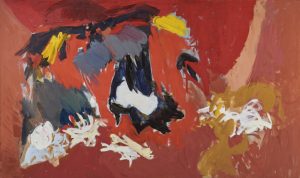
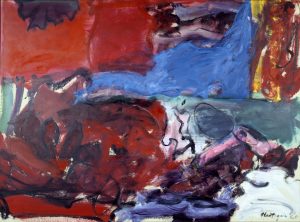
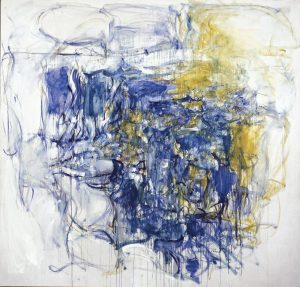
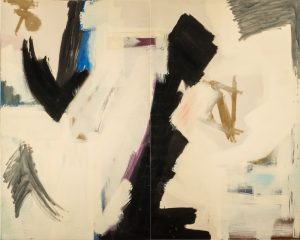
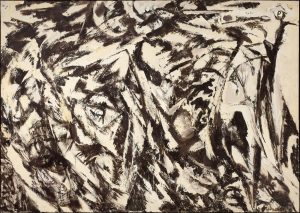
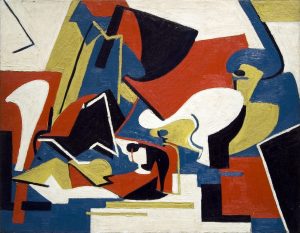
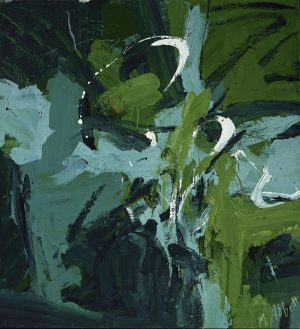
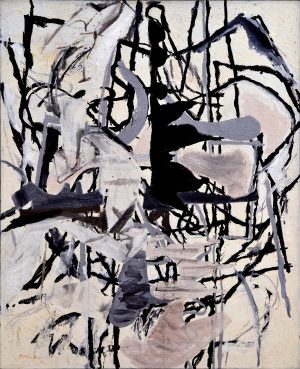
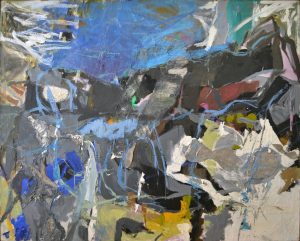
This is a thoughtful and blessedly jargon-free trip back to the days when American women began to think, act and express themselves in ways which were very different from their mothers, Having some of the work to see along with the words sends home the message that these paintings remain intriguing, challenging and vital to the understanding of abstract expressionism in the US.
Thank you Lucy Wiley. We appreciate you reading adobeairstream.com!